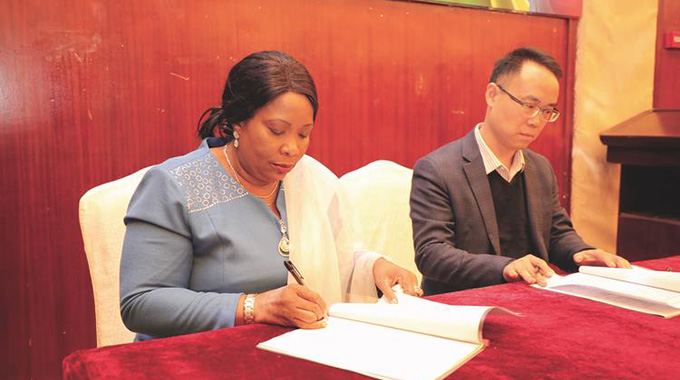Source: Chinese firm willing to invest in Zim | The Herald December 10, 2019
Angel of Hope Foundation Patron First Lady Auxillia Mnangagwa signs expression of interest documents with Techray Medical Technology Marketing CEO Mr Xie AoBing in Guangzhou, China, yesterday. — Pictures: John Manzongo Tendai Rupapa in Hunan, China
A CHINESE medical oxygen engineering firm has expressed willingness to set up manufacturing plants at Zimbabwe’s five referral hospitals in a development expected to reduce the country’s medical oxygen import bill.The move will ensure the health sector keeps abreast with changes in technology.
The innovative company — Techray Medical Technology Co Ltd — integrates research, design, production, sales, installation and after-sales and does oxygen purification, cylinder filling and water purification, among other services.
Techray focuses on the field of oxygen health, which is a professional brand in the industry of high-end medical molecular sieve oxygen-making.
Plans are already underway for Techray Medical Technology to conduct a feasibility study in Zimbabwe so that plants that are specific to the country’s needs can be established.
The firm’s representatives held a meeting with the First Lady Auxillia Mnangagwa and her delegation here during one of the Zimbabwe-China business meetings where they expressed interest and invited the delegation to a tour of their company.
Amai Mnangagwa then assigned experts from the Ministry of Health and Child Care, who are part of her delegation, to visit the company and have an appreciation of the plant.
Speaking during the tour, Mr Xie AoBing, the marketing CEO for Techray Medical Technology Co Ltd was optimistic the project will be a huge success.
He said the company has a strong innovative team of technical experts which has established a strong research centre integrating technical, professional and systematic research with international molecular sieve research institutions and universities.
The company owns more than 50 qualifications of new technology of intellectual property in the field of molecular sieve oxygen generation system.
The project, Mr Xie said, will be his firm’s first in Zimbabwe and providing an opportunity to introduce its technologically advanced plant to Zimbabwe.
“We want to create a new medical environment for Zimbabwean people as our oxygen generators are already exported to 35 countries around the world and are being used in more than 2 000 hospitals. We want to bring these oxygen generators to Zimbabwe and they have a 10-year warrant.
“I will travel with my team to Zimbabwe for feasibility study because our company manufactures the equipment according to a country’s scale of medical institutions. We would want to study the best plant for Zimbabwe’s hospitals,” he said.
Ministry of Health and Child Care’s chief hospital equipment technician Engineer Lovemore Musarurwa described the installation of oxygen plants in Zimbabwe as a milestone that curtails one of the major cost drivers in the health sector.
Eng Masarurwa said once operational, patients that require oxygen in hospitals, will get it at reasonably cheaper rates.
“A breakdown of the requirements shows that Parirenyatwa Hospital requires 35 tonnes of oxygen per month, while Sally Mugabe Hospital, formerly Harare Central Hospital, consumes 21 tonnes and the other hospitals require quantities ranging between 10 and 15 tonnes to contribute to the national requirement of 120 tonnes per month.
“In the long term, this kind of technology will be rolled out in provincial and district hospitals,” he said.
Techray officials said the move marked an important chapter for Zimbabwe to utilise innovations that are both cost effective and efficient for national development.
Zimbabwe’s director in the Ministry of Health and Child Care, Dr Bernard Madzima, who is also part of the delegation here, described the Techray Medical Technology plant in Changsha City in Hunan Province, as impressive.
“This is high-level technology and meets European standards. The company is a leader in oxygen processing. We want to thank Her Excellency the First Lady of Zimbabwe Amai Auxillia Mnangagwa for this initiative. It will go a long way in solving our hospital commodity expenses,” said Dr Madzima.
The First Lady is the country’s Health and Child Care ambassador.
In an interview, Amai Mnangagwa was on cloud nine, saying the oxygen plant will be a game-changer for the country’s hospitals which were saddled with high operating costs owing to some medical supplies and sundries that need to be imported.
“Oxygen is life, and with this technology in all the country’s five central hospitals, Zimbabwe will benefit immensely. Once we have the plant in place, all the foreign currency being used can be channelled towards other development programmes. This is good news to our country. The Chinese investor has expressed interest to set up a medical gas plant to be used across the five central hospitals in the country.
“Effectively, this is expected to reduce Government expenditure incurred through oxygen purchases,” she said.
ChinaBrand International Commercial invited Amai Mnangagwa here as patron of Angel of Hope Foundation and First Lady of Zimbabwe.
ChinaBrand, which is owned by Mrs Juliana Elhawary, invited her after following her empowerment work through her charity arm for the transformation of Zimbabwe.
The First Lady said prior to her visit when the Chinese delegation informed her on the areas they wanted to partner her foundation and investing in Zimbabwe, she saw it prudent to also engage ministries so that they get first hand information and also for them to exchange notes with the Chinese delegation.
Mrs Elhawary provided a list of ministries she wanted for the business meetings and the First Lady then sought permission from the President to include officials from ministries in her delegation, together with individual businesspeople.
Newer Post
Zanu-PF indaba kicks off today Older Post
Harare Hospital not closed 
COMMENTS
Zhing zhong time… There is always a price to be paid.